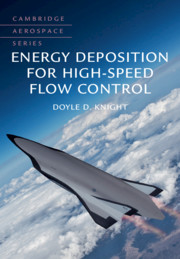Refine search
Actions for selected content:
5486 results in Thermal-fluids engineering
4 - Dynamics and Kinetics of Charged Particles
-
- Book:
- Energy Deposition for High-Speed Flow Control
- Published online:
- 08 February 2019
- Print publication:
- 21 February 2019, pp 67-85
-
- Chapter
- Export citation
6 - Microwave Discharge
-
- Book:
- Energy Deposition for High-Speed Flow Control
- Published online:
- 08 February 2019
- Print publication:
- 21 February 2019, pp 133-198
-
- Chapter
- Export citation
Frontmatter
-
- Book:
- Energy Deposition for High-Speed Flow Control
- Published online:
- 08 February 2019
- Print publication:
- 21 February 2019, pp i-iv
-
- Chapter
- Export citation
8 - Modeling Energy Deposition as an Ideal Gas
-
- Book:
- Energy Deposition for High-Speed Flow Control
- Published online:
- 08 February 2019
- Print publication:
- 21 February 2019, pp 243-272
-
- Chapter
- Export citation
5 - DC Discharge
-
- Book:
- Energy Deposition for High-Speed Flow Control
- Published online:
- 08 February 2019
- Print publication:
- 21 February 2019, pp 86-132
-
- Chapter
- Export citation
Author Index
-
- Book:
- Energy Deposition for High-Speed Flow Control
- Published online:
- 08 February 2019
- Print publication:
- 21 February 2019, pp 445-448
-
- Chapter
- Export citation
Appendix E - Bessel’s Equation
-
- Book:
- Energy Deposition for High-Speed Flow Control
- Published online:
- 08 February 2019
- Print publication:
- 21 February 2019, pp 369-371
-
- Chapter
- Export citation
Appendix D - Microwave Waveguides and Components
-
- Book:
- Energy Deposition for High-Speed Flow Control
- Published online:
- 08 February 2019
- Print publication:
- 21 February 2019, pp 342-368
-
- Chapter
- Export citation
References
-
- Book:
- Energy Deposition for High-Speed Flow Control
- Published online:
- 08 February 2019
- Print publication:
- 21 February 2019, pp 422-444
-
- Chapter
- Export citation

Energy Deposition for High-Speed Flow Control
-
- Published online:
- 08 February 2019
- Print publication:
- 21 February 2019
Index
-
- Book:
- Rocket Propulsion
- Published online:
- 21 March 2019
- Print publication:
- 07 February 2019, pp 570-574
-
- Chapter
- Export citation
Acknowledgments
-
- Book:
- Rocket Propulsion
- Published online:
- 21 March 2019
- Print publication:
- 07 February 2019, pp xii-xiv
-
- Chapter
- Export citation
Chapter 11 - Hybrid Rocket Engines
-
- Book:
- Rocket Propulsion
- Published online:
- 21 March 2019
- Print publication:
- 07 February 2019, pp 439-478
-
- Chapter
- Export citation
Chapter 7 - Solid Rocket Motors
-
- Book:
- Rocket Propulsion
- Published online:
- 21 March 2019
- Print publication:
- 07 February 2019, pp 229-281
-
- Chapter
- Export citation
Contents
-
- Book:
- Rocket Propulsion
- Published online:
- 21 March 2019
- Print publication:
- 07 February 2019, pp v-viii
-
- Chapter
- Export citation
Chapter 12 - Combustion Instability
-
- Book:
- Rocket Propulsion
- Published online:
- 21 March 2019
- Print publication:
- 07 February 2019, pp 479-525
-
- Chapter
- Export citation
Chapter 6 - Heat Transfer in Chemical Rockets
-
- Book:
- Rocket Propulsion
- Published online:
- 21 March 2019
- Print publication:
- 07 February 2019, pp 177-228
-
- Chapter
- Export citation
Chapter 10 - Rocket Turbomachinery Fundamentals
-
- Book:
- Rocket Propulsion
- Published online:
- 21 March 2019
- Print publication:
- 07 February 2019, pp 401-438
-
- Chapter
- Export citation
Chapter 2 - Mission Analysis Fundamentals
-
- Book:
- Rocket Propulsion
- Published online:
- 21 March 2019
- Print publication:
- 07 February 2019, pp 20-46
-
- Chapter
- Export citation
Chapter 13 - Electric Propulsion Fundamentals
-
- Book:
- Rocket Propulsion
- Published online:
- 21 March 2019
- Print publication:
- 07 February 2019, pp 526-554
-
- Chapter
- Export citation
